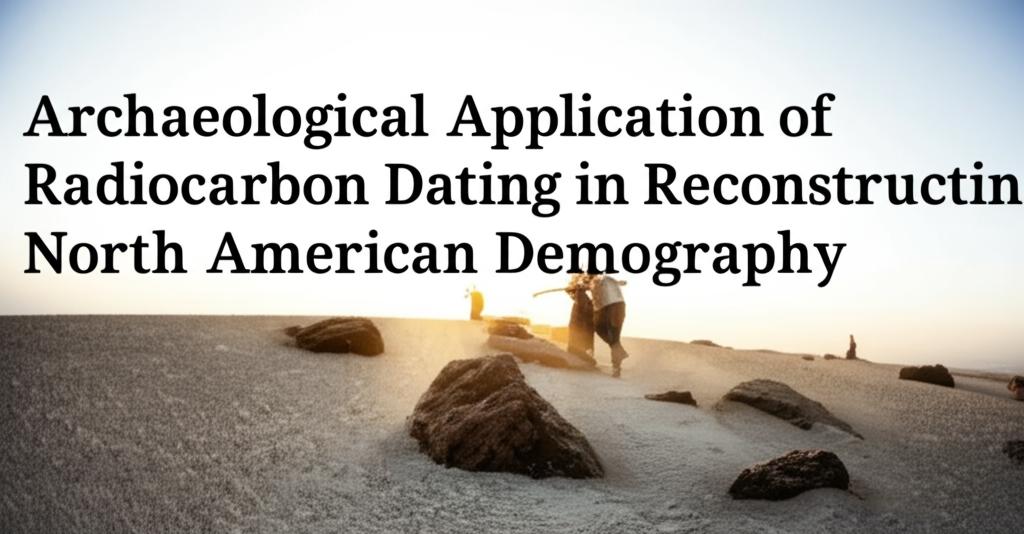Radiocarbon dating, a cornerstone of modern archaeology, has significantly reshaped our understanding of North American prehistory, particularly in reconstructing demographic patterns. This method allows for the dating of organic materials up to approximately 50,000 years old, providing crucial insights into human population fluctuations across the continent.
Fundamentals of Radiocarbon Dating in ArchaeologyRadiocarbon dating operates on the principle of the decay of carbon-14 (¹⁴C), a radioactive isotope of carbon. Living organisms continuously absorb ¹⁴C from the atmosphere. Upon death, this absorption ceases, and the ¹⁴C within the organic remains begins to decay at a known rate, with a half-life of about 5,730 years. By measuring the remaining ¹⁴C in archaeological samples like charred plant remains, animal bones, and shells, scientists can calculate the time elapsed since the organism's death.
While stone tools and pottery cannot be directly dated as they are inorganic, associated organic materials found alongside these artifacts can provide contextual dates for their use. Advances such as Accelerator Mass Spectrometry (AMS) dating have revolutionized the field by enabling the dating of very small samples, like a single kernel of corn, through the direct counting of ¹⁴C atoms. This precision is vital for understanding cultural changes over time.
Reconstructing North American Indigenous Population DynamicsRecent studies utilizing large datasets of radiocarbon dates, such as those from the Canadian Archaeological Radiocarbon Database (CARD), have revealed significant fluctuations in Indigenous populations across North America before European contact. These analyses, often focusing on "summed probability distributions" (SPDs) of radiocarbon dates, act as a proxy for past human population sizes – the assumption being that a higher number of dated samples from a specific period correlates with a larger population.
A continental-scale analysis of radiocarbon dates from the past 2,000 years indicates a peak in the Indigenous population of what is now the continental U.S. around 1150 CE. This was followed by a decline and stabilization by approximately 1450 CE, before a further sharp decrease after European arrival. However, these trends were not uniform across the continent.
By examining radiocarbon records from 18 major watersheds, researchers have found that population peaks and declines occurred at different times in different regions. For instance, some areas experienced population peaks as early as 800-770 CE, while others saw declines between 1080 and 1300 CE, particularly in the interior regions. In contrast, areas like the Great Lakes, New England, the Mid-Atlantic, the Central Plains, the Northwest, and California appeared to have stable or growing populations that did not decline until after European contact.
Addressing Challenges and Advancing MethodologiesWhile immensely valuable, the "dates as data" approach has inherent challenges. Fluctuations in atmospheric ¹⁴C levels over time require calibration curves to convert radiocarbon years into calendar years. The shape of this calibration curve itself can sometimes create biases in SPDs, potentially mimicking population changes where none occurred. Additionally, "investigation bias" – where archaeologists might favor certain periods or materials for dating – can skew the data.
To address these issues, researchers are developing new statistical methods. For example, comparing radiocarbon time series with other palaeodemographic proxies, like dendrochronological (tree-ring) data, helps to validate population reconstructions. Studies in the American Southwest have used this multi-proxy approach to confirm population declines between AD 1300 and 1600, lending greater confidence to radiocarbon-based reconstructions in other regions where such cross-checks may not be as readily available.
Newer Bayesian statistical models are also being employed to refine population estimates by incorporating probability analytics to account for the error margins inherent in radiocarbon dates. These advancements aim to provide more accurate and nuanced reconstructions of past demographic shifts.
Regional Variations and Pre-Contact DeclinesThe data suggests that pre-contact population declines in some regions were likely due to a combination of factors, including climate change (especially drought), disease in densely populated settlements, emigration, and warfare. Importantly, these pre-Columbian declines indicate a dynamic and fluctuating demographic landscape long before European arrival. Had Europeans arrived a few centuries earlier, they might have encountered larger, more cohesively organized Indigenous societies in certain areas.
The ability of radiocarbon dating to pinpoint the timing of these demographic shifts provides invaluable context for understanding the impact of European colonization. For instance, revised dating of sites like the Jean-Baptiste Lainé Site in Ontario, using advanced modeling of tree-ring and carbon data, has shifted its occupation period significantly, suggesting later initial interactions between Indigenous communities and Europeans than previously thought and highlighting Indigenous persistence and adaptation.
The Future of Radiocarbon Dating in North American DemographyThe ongoing compilation and refinement of radiocarbon databases, coupled with advancing analytical techniques, continue to enhance our ability to reconstruct the complex demographic history of North America. These efforts not only shed light on ancient population dynamics but also challenge long-held narratives about Indigenous societies before and after European contact. By providing robust timelines, radiocarbon dating remains an indispensable tool for archaeologists seeking to understand the peopling of the continent and the multifaceted histories of its Indigenous populations. The development of publicly accessible databases incorporating tens of thousands of dates will further empower researchers to investigate a wide array of questions about North America's ancient past.

